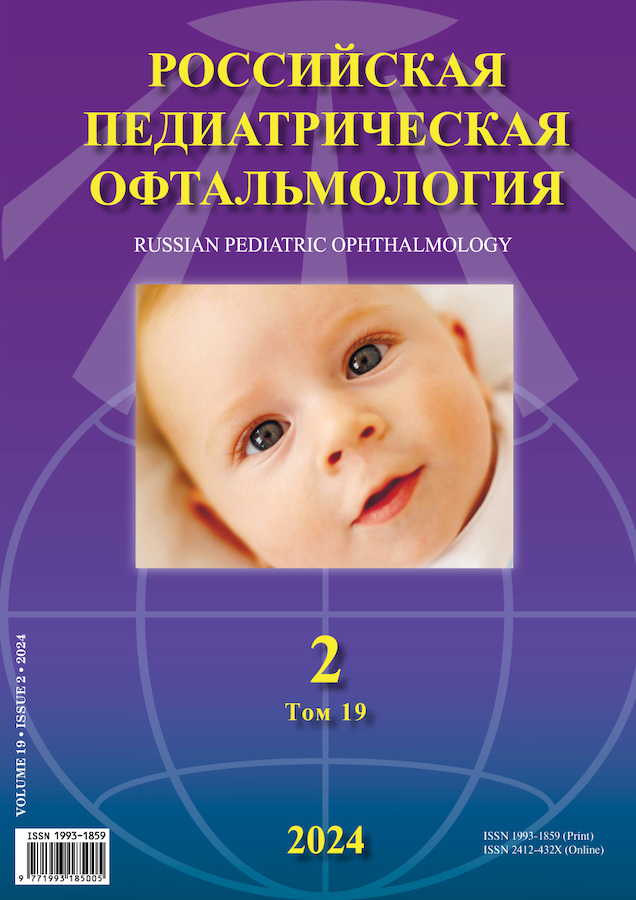A case of varicose necrotic phlegmon of the orbit in a child
- Authors: Malinovskaya N.A.1,2, Nikonorova P.A.1, Anikieva A.V.1
-
Affiliations:
- C.A. Rauhfus Children’s Сity Multidisciplinary Clinical Center of High Medical Technologies
- North-West State Medical University named after I.I. Mechnikov
- Issue: Vol 19, No 2 (2024)
- Pages: 101-106
- Section: Case reports
- Published: 14.06.2024
- URL: https://ruspoj.com/1993-1859/article/view/631422
- DOI: https://doi.org/10.17816/rpoj631422
- ID: 631422
Cite item
Abstract
AIM: This study aimed to analyze the peculiarities of a clinical case of orbital cellulitis in a child with varicella-zoster virus infection.
MATERIAL AND METHODS: In this report of a rare case, necrotizing orbital cellulitis developed on day 6 from the onset of varicella-zoster disease in a 5-year-old child. The child was hospitalized in a serious condition at the intensive care unit of an infectious disease hospital and was subsequently transferred to an ophthalmology department of another hospital. The patient was subjected to comprehensive laboratory examinations and received conservative and surgical treatments. Computed tomography was performed to detect changes in the status of the orbits.
RESULTS: The disease manifested with a pronounced pain syndrome in the right orbit, intoxication, and hyperthermia. Exophthalmos, purulent discharge, and necrosis of the conjunctiva of the affected eye were also observed. Computed tomography revealed infiltration of the right orbit without changes in the sinuses. The clinical blood analysis demonstrated leukocytosis, left shift in neutrophils, eosinophilia, and high levels of C-reactive protein and lactate dehydrogenase. The coagulogram demonstrated a proclivity toward hypercoagulation, as evidenced by diminished prothrombin activity according to Quick’s test, increased active partial thromboplastin time, and high D-dimer levels. Urinalysis revealed leukocyturia. Cultures from the conjunctival cavity yielded Streptococcus pyogenes, and a polymerase chain reaction tested positive for S. pyogenes. Antiviral, antibacterial, and symptomatic treatments were initiated. Necrotic masses were obtained during the drainage of the orbital cavity. The child was hospitalized for 21 days. The symptoms were controlled, and the patient’s condition was satisfactory at discharge. Visual functions remained fully preserved. At the examination 1.5 months later, a slight residual exophthalmos was detected.
CONCLUSION: Employing a complex multidisciplinary approach, timely prescription of antibacterial and antiviral therapy, and surgical assistance (drainage of the orbit) ensures a successful disease outcome.
Keywords
Full Text
About the authors
Natalia A. Malinovskaya
C.A. Rauhfus Children’s Сity Multidisciplinary Clinical Center of High Medical Technologies; North-West State Medical University named after I.I. Mechnikov
Email: benimor100@mail.ru
ORCID iD: 0000-0002-4560-6239
SPIN-code: 8306-9359
MD, Cand. Sci. (Med.)
Russian Federation, 8, Ligovsky pr., 191036 Saint-Petersburg; Saint-PetersburgPolina A. Nikonorova
C.A. Rauhfus Children’s Сity Multidisciplinary Clinical Center of High Medical Technologies
Author for correspondence.
Email: polina.lepihina@yandex.ru
ORCID iD: 0000-0003-3369-3344
MD, ophthalmologist
Russian Federation, 8, Ligovsky pr., 191036 Saint-PetersburgAnastasia V. Anikieva
C.A. Rauhfus Children’s Сity Multidisciplinary Clinical Center of High Medical Technologies
Email: nancy.anikieva@gmail.com
ORCID iD: 0009-0009-4971-4964
MD, ophthalmologist
Russian Federation, 8, Ligovsky pr., 191036 Saint-PetersburgReferences
- Kuzmin AI, Barskaya MA, Zavyalkin VA, et al. Necrotic epifascial phlegmon // Modern Problems of Science and Education. 2015;12(7):1242–1243. EDN: VJFTYV
- Samodova OV, Krieger EA, Titova LV. Bacterial complications of chickenpox in children. Children infections. 2015;(3):56–60. EDN: UKLIHX doi: 10.22627/2072-8107-2015-14-3-56-60
- Berdouk S, Pinto N. Fatal orbital cellulitis with intracranial complications: a case report. Int J Emerg Med. 2018;11(1):51. doi: 10.1186/s12245-018-0211-x
- Lee S, Yen MT. Management of preseptal and orbital cellulitis. I2011;25(1):21–29. doi: 10.1016/j.sjopt.2010.10.004
- Murphy C, Livingstone I, Foot B, et al. Orbital cellulitis in Scotland: current incidence, aetiology, management and outcomes. Br J Ophthalmol. 2014;98(11):1575–1578. doi: 10.1136/bjophthalmol-2014-305222
- Segal N, Nissani R, Kordeluk S, et al. Orbital complications associated with paranasal sinus infections-A 10-year experience in Israel. Int J Pediatr Otorhinolaryngol. 2016;(86):60–62. doi: 10.1016/j.ijporl.2016.04.016
- Tsirouki T, Dastiridou AI, Ibánez Flores N, et al. Orbital cellulitis. Surv Ophthalmol. 2018;63(4):534–553. doi: 10.1016/j.survophthal.2017.12.001
- Wong SJ, Levi J. Management of pediatric orbital cellulitis: A systematic review. Int J Pediatr Otorhinolaryngol. 2018;110:123–129. doi: 10.1016/j.ijporl.2018.05.006
Supplementary files











